| Published
on 8
Jul 2018 |
All rights reserved.
|
|
|
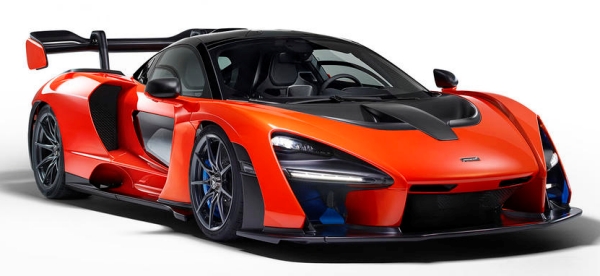
|
|
The
McLaren Senna is a great car, unquestionably, just not the Senna kind
of car.
|
|
This is only the second
McLaren “Ultimate Series” car. While the P1 still occupies the top spot
in market positioning (£866,000), the new car is not far adrift
(£750,000). In terms of performance, it may even eclipse the P1 –
not quite straight line speed, but definitely cornering speed hence
overall lap time. This is because it is the company’s most extreme
road-legal track car, or track-oriented road car, whatever you call it.
The only question is the name. What name should be used to represent
such an extreme machine? Ferrari has Enzo, but McLaren cannot call its
car “Bruce” or “Dennis”. They looked up their vocabulary and found a
cool name: Senna.
Ayrton Senna served McLaren F1 team from 1988 to 1993, winning all his
3 world championship titles with Woking. He was the world’s fastest
driver and probably the most aggressive one as well until now. The
business men at McLaren contacted his nephew, Bruno Senna (himself also
a racing driver, if far less successful), and forged an agreement with
his family’s Senna Foundation for using the name. Not sure if it means
Bruno or Ayrton, but Senna anyway. McLaren will donate money as well as
the last of the 500 cars slated for production to the foundation for
charity. All 500 cars will be delivered within this year, and
unsurprisingly, all of them were already sold.
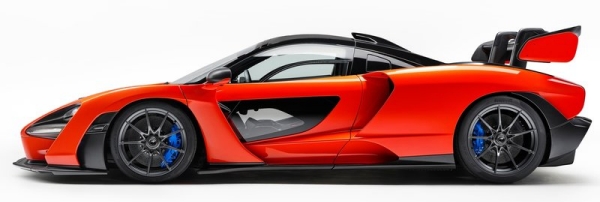
|
|
Roof-mounted
intake and small sliding windows are genes taken from the legendary F1.
|
|
The problem is, is this Ayrton Senna kind of car? Most people remember
Senna helped Honda to develop NSX,
the world’s most easy-going supercar
then. Honda gifted him 2 cars as his personal transport. What you
might not know are the other cars ever owned by Senna: Ford Escort XR3
(before he got famous), Mercedes
190E 2.3-16, Mercedes
500SEC, Audi S4 (the hot version of 100) and the last one Mercedes 600SL. Most of
them are comfortable luxury cars and none are extreme track-biased
machines (BTW, he
worked for Lotus but he never owned a Seven). As aggressive as he drove
in F1 racing, he was a more relaxing guy elsewhere. The McLaren Senna
is a great car, unquestionably, just not the Senna kind of car.
But the car is innocent. In fact, its design and engineering are quite
adorable. We are not talking about McLaren F1, Bugatti Veyron or
Porsche 918 Spyder
level of innovation or technological breakthrough. The Senna is pretty
conventional in concept, but it follows the racing principles to pursue
performance by reducing weight, adding power and downforce. It abandons
the hybrid power of P1 so that it can be made 200kg lighter, which has
enormous effect to track performance. What it loses in electrical boost
is partly compensated by boosting the output of its twin-turbo V8 to
800 horsepower, 80 more than the 720S. BTW, it also undercuts the
latter by 85kg, thanks to extreme weight trimming. As a result, it will
accelerate from rest to 124mph in the same 6.8 seconds as the P1. Only
after that it will start losing ground to the P1 due to its
downforce-oriented shape and the difference of 116 horsepower. Flat
out, it will do 211mph like the 720S, but top speed is no longer
relevant to a track car.
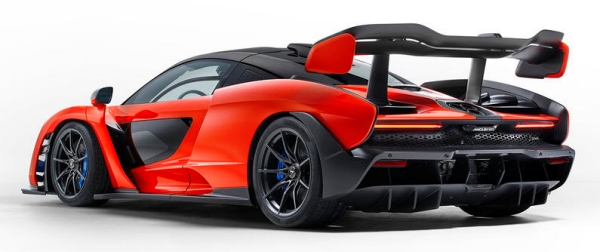 |
|
The
huge rear wing contributes to 500kg downforce. The whole car produces
800kg.
|
|
In terms of design, the Senna also turns head. While it is no work of
art, just like Ferrari F40, it looks as aggressive and fresh as you
want. Undoubtedly the car is shaped by aerodynamics and cooling
function. Huge wings and diffusers and large openings reinforce the
image of a track car, but it has enough style to avoid being dubbed a
Gumpert Apollo-plus. The bubble glasshouse has strong resemblance to
the legendary F1, thanks in part to the roof-mounted intake and the
small sliding windows. The doors can be fitted with glass panels to
improve visibility, which looks cool, too.
Its high-mounted rear wing consists of two planes and its angle is
hydraulically adjustable through 25 degrees. The wing is suspended by
carbon-fiber brackets, like Koenigsegg One:1, so to enable a smooth
underside for the best effect of aerodynamics. Up front, there is a
pair of active aero blades located just above the front splitter, which
is made possible by relocating the radiators from the nose to the rear
of the car (at the expense of luggage compartment). Unsurprisingly,
such an extreme shape results in extreme downforce. While a 911 GT3 RS
offers 500kg at 186mph, and the P1 manages 600kg at 161mph, the Senna
produces 800kg at only 155mph! Beyond that speed its wings will be
scaled back slightly, reducing drag while keeping downforce at 800kg.
Drag coefficient? Who cares when you can reach 211mph?
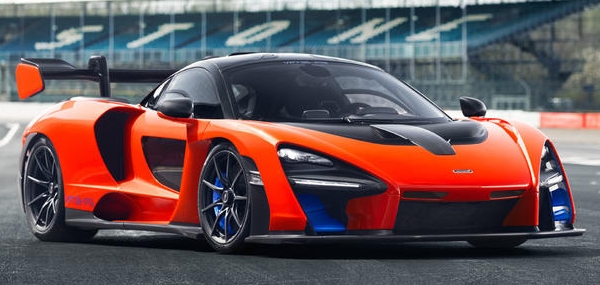
|
|
The
Senna will stop from 124mph in 100 meters, 16 less than the P1.
|
|
McLaren is able to introduce a new car every few months because all its
cars are derived from the same parts pool. Senna is no different. The
so-called MonoCage III carbon-fiber central chassis is close to that of
the 720S, but is now integrated with the bulkhead to make it stronger
while saving 18kg. Up front is still an aluminum subframe. The PCC
hydraulically interconnected adaptive suspension system gets a new
name, RaceActive Chassis Control, but I don't see any differences
except tuning, which is more track-oriented, of course. To enhance
mechanical grip, track-biased Pirelli P-Zero Trofeo R rubbers are
employed, and the rear tires get 10mm wider than those of 720S. The
carbon-fiber brakes have been upgraded to Brembo CCM-R, which is closer
to racing items, more powerful, more resistant to heat, more durable
and also more expensive. The Senna will stop from 124mph in 100 meters,
16 less than the P1.
Its 1198kg dry weight is not quite as good as the mighty F1, but
remarkable for supercars these days, especially when billionaires
cannot live without luxuries like air-con, infotainment system and even
cruise control. Senna cuts weight by using carbon-fiber to construct
its body panels (whereas aluminum is used on 720S). Its butterfly doors
alone are 18kg lighter, thanks in part to the lack of inner door
panels. The carbon-shell racing buckets weighs only 3.3kg each, while
the cockpit has virtually no soft trims except the thin carpets. Ayrton
Senna might not be pleased.
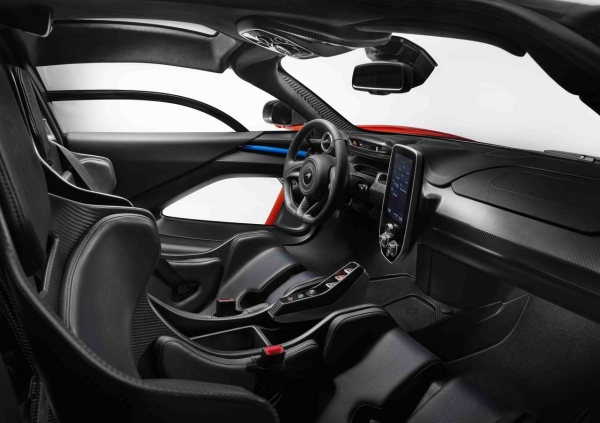
|
|
The
cockpit has virtually no soft trims except the thin carpets. Ayrton
Senna might not be pleased.
|
|
You need some gymnastic training to get through the small door aperture
and high sills into the snug cockpit. However, once inside, it is not
so tight in the context of supercars. In fact, benefitted by the glass
roof and door panels, it feels quite airy. Some switches have been
moved to the roof to free up the center console, which is a
space-saving flat panel. The strange instrumentation of 720S is carried
over. Normally it is a TFT screen. When you switch to Track mode, it
will fold down and reveal a simplified digital readout of only rev,
speed and gear selected. Carbon-fiber is exposed everywhere. I am not
sure if this means taste, but on road it must be noisy. The racing
bucket holds you tight but you are unlikely to appreciate its comfort
over long journeys, which reminds you this is not a GT after all.
The M840TR engine differs from the M840T of 720S in only details:
carbon-fiber intake plenum, revised cam timing, new pistons, upgraded
fuel pumps… and the whole engine is 2kg lighter. It breathes through a
lighter Inconel-titanium exhaust. Power delivery is linear, turbo lag
remains low, power band is wide, the noise gets a harder edge but
unfortunately still lack of soul. There is more vibration can be felt
through the stiffer engine mounts. Among all things, the V8 is a
relatively weak point of the Senna. While quantity is not in short
supply, it lacks the quality that distinguishes a great supercar engine
from an ordinary one. It just needs more character. Comparatively, the
Graziano twin-clutch gearbox is near perfect, with fast and smooth
gearshifts.
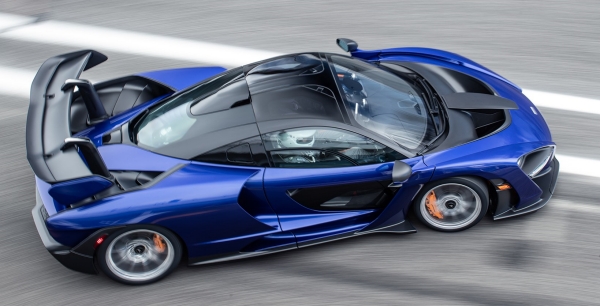
|
|
Terrific
roadholding thanks to tremendous mechanical grip and huge downforce.
|
|
How does it perform on road? At the moment, no one outside McLaren
knows, because McLaren has offered the car for test only in Silverstone
and Estoril. We would be pleased to see how it deals with bumpy
mountain roads, where LaFerrari demonstrated a very good manner, and
especially when it is shod with more weather-proof road tires instead
of the Trofeo R. Before then, it will be unfair to make a final
judgment.
However, as a car born for track in the primary sense, the Senna does
perform flawlessly on track. Switch on Track mode, the car has its
hydraulic suspension dropped to the lowest position while stiffening
the damping, and the wings are adjusted to maximum attack angle. In
this way, it simply ticks all boxes. Rock-steady control? Yes. Terrific
roadholding? Yes, thanks to tremendous mechanical grip and huge
downforce. Steering? Yes, feelsome, precise and wonderfully weighted
(it remains electrohydraulic-assisted, mind you). The nose follows the
steering instantaneously. Brakes? Amazingly powerful, simply
unprecedented for a road car, and the pedal modulation is perfect.
At-the-limit behavior? The car is set up to a little understeer, as
required by a track car, but it will turn progressively into the corner
with a gentle lift of throttle or a soft braking. Despite the
aggressive looks, the Senna is surprisingly friendly at the limit. Its
inherent balance is excellent, and the stability control does its job
unintrusively. You can trust it and build confidence on it with laps
after laps of practice, discovering its enormous potential, especially
the brakes, run deeper and deeper into the turns. That’s why it is so
rewarding to drive.
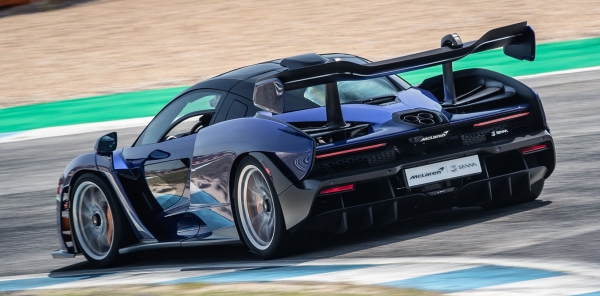
|
|
Despite
the aggressive looks, the Senna is surprisingly friendly at the limit.
|
|
Then, is it better than the hybrid supercar trio of LaFerrari, P1 and
918 Spyder, or the new Bugatti, the evergreen Koenigsegg and Pagani?
Base on track drive alone it is hard to say, but in the end it will be
down to how you see a supercar. For long we think supercars should have
these qualities: exotic looks, extreme performance and innovation. The
Senna has the first and second but the last element is rather mild.
Since it is built on racing principles, you can foresee even faster
track-oriented McLarens to arrive in the next few years. For example,
when newer generation of carbon brakes is available, you will no longer
remember the Senna for braking. What leaves in the memory of car
enthusiasts is something more than numbers. It may be technological
breakthrough, maybe an unforgettable shape, a new found character…
Aryton Senna is still remembered by us not just because he drove faster
than the rest of the crowd of his time, but he had a truly distinctive
character. The McLaren seems to lack that element.
|
Verdict:      |
|